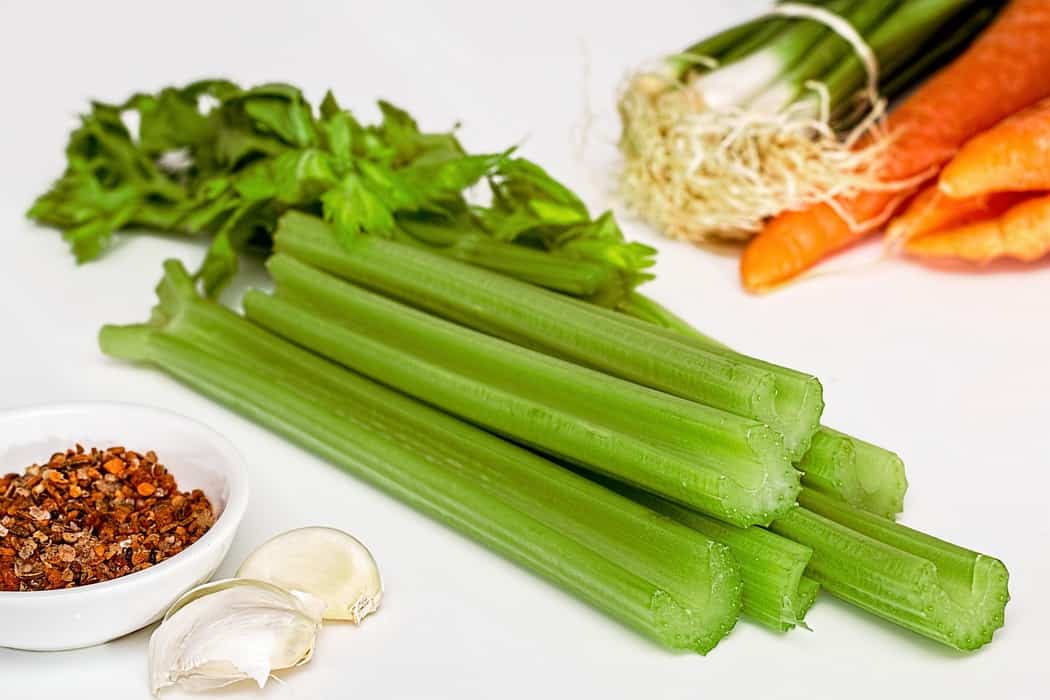The keto diet can be pretty challenging compared to other types of diets.
After all, fruits and vegetables are usually highly recommended and encouraged on a lot of weight loss diets, but unfortunately a lot of them done with too many carbs to be keto-friendly.
Because of this, it can be challenging for new keto dieters to know exactly what’s safe, and how much is safe for ketosis, even when eating healthy foods like vegetables.
Celery was one of my favorite veggie snacks before going into keto, so I set out to learn just how low carb it is so that I could better fit it into my keto regimen. What I found out was actually pretty interesting.
Let’s start with the fast nutrition facts on celery
Nutrition Facts of Celery
As a vegetable, celery is a staple for a lot of different types of diets. It’s nutrition facts for one medium stalk serving (about 40 grams) include the following:
- Protein – 0.3 grams per serving
- Calories – 6 per serving
- Sodium – 32 mg per serving
- Potassium – 104 mg per serving
- Carbohydrates – 1.2 grams per serving
- Fiber – 0.6 grams per serving
- Fat – 0.1 grams per serving
- Calcium – 2% of recommended daily amount
- Vitamin A – 4% of recommended daily amount
- Vitamin C – 2% of recommended daily amount
Celery is characterized as a marshland plant, and its seeds are also often used as spices and ingredients in herbal medicine.
The three main types of celery are: pascal celery, leaf celery, and celeriac celery. There aren’t many nutritional differences across the three, but pascal celery is the one most commonly eaten in the United States.
Because of its low calorie count but high fiber content, celery is often recommend by doctors and nutritionists as a great vegetable for weight loss. It’s also extremely hydrating, because the vegetable contains more water than most vegetables.
You may have also heard about celery’s calorie deficit properties, which are in fact true – you actually burn more calories chewing and digesting celery, than the calories of energy it provides as a food. This makes it a great snack for those trying to lose weight by trying to attain a caloric deficit in their daily routines.
However veggies can be tricky on the keto diet. Even though they’re all high in fiber, some can still come with a few too many carbs.
Let’s examine just how keto-friendly celery is.
Is Celery Keto-Friendly?
Celery only has 1.2 grams of carbs per serving, and 0.6 of those come from fiber, which means each serving only has 0.6 net carbs. Because of this, celery is definitely a great keto-friendly option.
On top of that, the low calorie counts make it even more beneficial for those using keto as a way to lose weight.
While there are a lot of benefits of celery, especially for those following low carb diets, there are some slight risks and side effects for certain groups of people that you might want to be aware of.
I’ll get into the specific pros and cons next.
Benefits of Celery
-
Reduces inflammation
Celery is an excellent source of apigenin, which is a molecule that at this moment is being studied for its anti-cancer properties via inflammation reduction.
A recent study found that apigenin and diets rich in apigenin were able to reduce the presence of specific types of inflammatory proteins found in mice. From this conclusion, it’s possible that scientists can therefore reduce inflammation and restore immune balance by implementing a diet rich in these molecules through celery.
On top of apigenin, celery stalks and seeds have roughly 25 other anti-inflammatory compounds that have been proven to offer protection against natural causes of inflammation within the body.
-
Great source of vital antioxidants
Celery is a rich source of antioxidants. Antioxidants are an important part of any diet because they work to protect the structure and health of cells, blood vessels, and prevent internal organs from suffering any oxidative damage.
The primary antioxidants and phytonutrients that are found in celery include: vitamin C, beta carotene, potassium, magnesium, folate, vitamin K, flavones, flavonols, dihydrostilbenoids, and phenolic acids.
Additionally, celery is able to retain most of it’s antioxidants after being cooked. A recent study concluded that even after 10 minutes of steaming celery was able to maintain 83 to 99 percent of its antioxidants, which is an incredible amount, considering most vegetables lose most of their beneficial nutrients after being cooked.
-
Supports digestion
Celery provides a lot of digestion help, for keto diets and really any other diets. This is part of the reason why fresh celery juice is so popular right now.
Celery is a nutritional source of pectin-based polysaccharides, which include a compound known as apiuman. These polysaccharides have been linked to a measured decrease in the frequency of developed stomach ulcers, an improvement of the lining of the stomach, and an ability to regulate stomach secretions in animal studies.
All of this combined helps keep digestion running smoothly, and reduces symptoms like nausea and bloating.
-
Lowers bad cholesterol levels
A recent study from the Journal of Agriculture and Food Chemistry concluded that eating celery every day may be able to help to reduce levels of artery-clogging cholesterol (medically referred to as LDL or bad cholesterol).
This effect comes from the phthalides found in celery, which contribute to stimulating the secretion of bile juices within the digestive system. These juices then work to reduce LDL cholesterol levels.
-
May help treat high blood pressure
Those same phthalides that are helpful for reducing bad cholesterol levels have also been known to reduce the overall level of the stress hormones within your blood.
This reduced stress can play a big role in reducing blood pressure, and lowering one’s overall risk for hypertension.
Celery is also a great source of potassium, which is characterized as a vasodilator, meaning it helps to reduce general high blood pressure throughout the body.
Reducing high blood pressure is important because once it is reduced, it then puts less stress on the entire cardiovascular system, thereby reducing the chances of developing other cardiovascular issues such as heart attack or stroke.
Side Effects of Celery
-
May cause allergies
Celery has been known to cause allergic reactions in certain types of people who are sensitive to a group of plants and spices including carrot, plantain, parsley, mugwort, birch, caraway, fennel or coriander seeds, anise, and dandelion.
This allergy is most commonly referred to as the “celery-carrot-mugwort-spice syndrome,” or the “celery-mugwort-birch-spice” syndrome.
Symptoms of this kind of allergic reaction can include itching and rashes, swelling of the mouth, tongue, throat and face, dizziness, and occasionally an upset stomach.
Unlike some other types of food allergies, cooking does not have an affect the allergenic potential when it comes to eating celery.
-
Can affect the central nervous system
This is mostly a negative effect for this in, before, or after surgeries. There is some concern that celery, when consumed in combination with anesthesia and other medications that are used before, during, or after surgery might have a slowing effect on the central nervous system that is too severe.
For this reason, it’s advised that anyone should refrain from eating any celery at least two weeks prior leading up to a surgery date.
-
Potential kidney issues
It’s been advised not to eat celery if you have pre-existing kidney problems. While they have been shown to reduce inflammation in most, they can cause some inflammation in the kidneys, especially if problems already exist.
Part of this side effect is due to the fact that celery is both rich in water and like water, can act as a natural diuretic on its own.
Because of this, people with kidney problems should keep close track of their daily celery intake, as excessive consumption of celery might end up placing unnecessary amounts of strain on their kidneys.
Keto-Friendly Celery Recipes
Because it’s safe to assume celery is keto-friendly, I figured I’d include some of my favorite celery keto meals and snacks.
All of these recipes are low in net carbs, and make the most out of this negative calorie superfood.
-
Baked Cheese Celery
Cheese is a great way to add a bunch of healthy fat and protein to any dish, and it goes especially well with vegetables.
The ingredients are fairly simple too:
-
- A quarter tablespoon of salt
- A half cup of heavy cream
- 3/4 cup of grated cheddar cheese
- 8 medium stalks of celery
- 1/3 cup of vegetable broth
- 1/4 teaspoon of salt
- 1/4 teaspoon of pepper
My favorite part about this dish is that its easy, and takes hardly any time at all to make. The directions are simple too:
-
- Preheat your oven to 400° Fahrenheit
- Cut your celery sticks down the center, and boil together for about 4 to 5 minutes of simmering
- After that, just drain the water from the celery, and place the sliced stalks on a baking tray
- Separately, you’ll want to combine the heavy cream, cheese, broth, and salt together in a pan, on low heat. Continue to stir this mixture together until the cheese fully melts
- Then poor the mixture slowly over the celery stalks, and put them in the oven for 18 to 20 minutes
-
Buffalo Chicken Celery Boats
This one’s great if you’ve been missing the taste of spicy chicken wings. The ingredients are:
-
- 1/3 cup of Frank’s Hot Sauce
- 2 tablespoons of mayonnaise
- A pinch of kosher salt
- Freshly ground black pepper
- 2 cups of shredded rotisserie chicken
- 1/3 cup of bleu cheese (or any melty cheese you like)
- Keto-friendly ranch dressing
The directions are pretty simple too:
-
- In one medium bowl, mix together the hot sauce and mayo with salt and pepper until combined. Then pour it over the shredded chicken, and combine them all together
- Spoon the chicken mixture onto medium stalks of celery, forming celery boats
- Top with cheese and ranch as desired
-
Celery and Cream Cheese
This last one is simple and tasty. Just grab keto-friendly cream cheese, and spoon it onto your celery, and you’ve got some great snacks ready to go! It works other easy foods like tuna, cheese dip, and peanut butter too!


